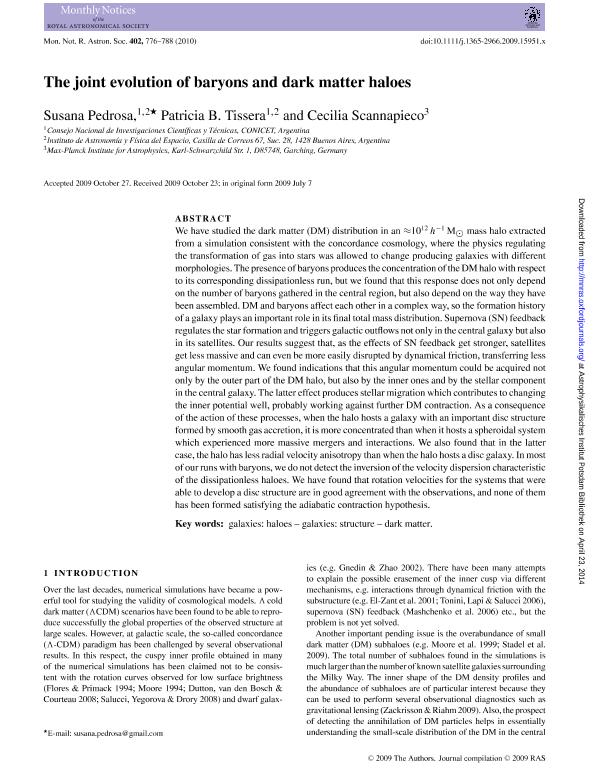Artículo
The joint evolution of baryons and dark matter haloes
Fecha de publicación:
02/2010
Editorial:
Wiley Blackwell Publishing, Inc
Revista:
Monthly Notices of the Royal Astronomical Society
ISSN:
0035-8711
Idioma:
Inglés
Tipo de recurso:
Artículo publicado
Clasificación temática:
Resumen
We have studied the dark matter (DM) distribution in an ≈1012 h−1 M mass halo extracted from a simulation consistent with the concordance cosmology, where the physics regulating the transformation of gas into stars was allowed to change producing galaxies with different morphologies. The presence of baryons produces the concentration of the DM halo with respect to its corresponding dissipationless run, but we found that this response does not only depend on the number of baryons gathered in the central region, but also depend on the way they have
been assembled. DM and baryons affect each other in a complex way, so the formation history of a galaxy plays an important role in its final total mass distribution. Supernova (SN) feedback regulates the star formation and triggers galactic outflows not only in the central galaxy but also in its satellites. Our results suggest that, as the effects of SN feedback get stronger, satellites get less massive and can even be more easily disrupted by dynamical friction, transferring less
angular momentum. We found indications that this angular momentum could be acquired not only by the outer part of the DM halo, but also by the inner ones and by the stellar component in the central galaxy. The latter effect produces stellar migration which contributes to changing the inner potential well, probably working against further DM contraction. As a consequence of the action of these processes, when the halo hosts a galaxy with an important disc structure formed by smooth gas accretion, it is more concentrated than when it hosts a spheroidal system which experienced more massive mergers and interactions. We also found that in the latter case, the halo has less radial velocity anisotropy than when the halo hosts a disc galaxy. In most of our runs with baryons, we do not detect the inversion of the velocity dispersion characteristic of the dissipationless haloes. We have found that rotation velocities for the systems that were able to develop a disc structure are in good agreement with the observations, and none of them has been formed satisfying the adiabatic contraction hypothesis.
Palabras clave:
Galaxies:Haloes
,
Galaxies:Structure
,
Dark Matter
Archivos asociados
Licencia
Identificadores
Colecciones
Articulos(IAFE)
Articulos de INST.DE ASTRONOMIA Y FISICA DEL ESPACIO(I)
Articulos de INST.DE ASTRONOMIA Y FISICA DEL ESPACIO(I)
Citación
Pedrosa, Susana Elizabeth; Tissera, Patricia Beatriz; Scannapieco, Cecilia; The joint evolution of baryons and dark matter haloes; Wiley Blackwell Publishing, Inc; Monthly Notices of the Royal Astronomical Society; 402; 2; 2-2010; 776-788
Compartir
Altmétricas




